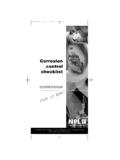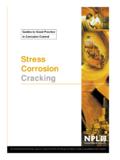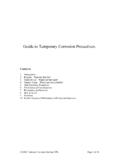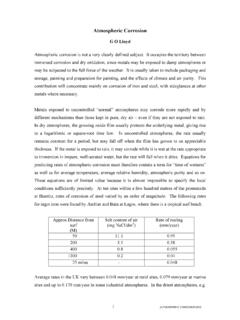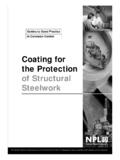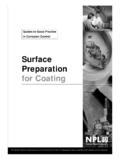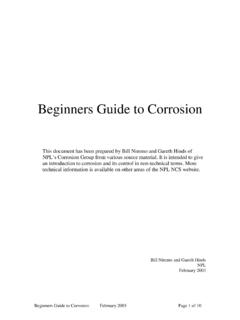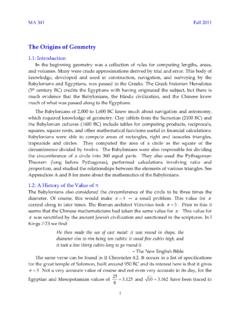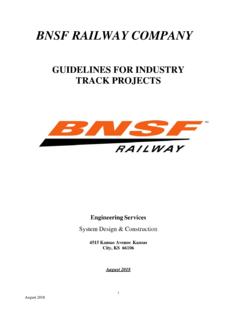Transcription of corrosion control in engineering design
1 1 [ corrosion control /BM] corrosion control in engineering design Contents CHAPTER 2 INTRODUCTION AND THE SIGNIFICANCE OF corrosion .. 2 CHAPTER 10 RELATION TO 10 STATIC SITUATIONS .. 10 DYNAMIC SITUATIONS .. 14 THE METAL AS PART OF A design .. 21 CHAPTER 24 PREVENTIVE MEASURES .. 24 CHAPTER 30 30 SOME INTERESTING READING ..Error! Bookmark not defined. 2 [ corrosion control /BM] CHAPTER 1 INTRODUCTION AND THE SIGNIFICANCE OF corrosion corrosion involves the reaction of a metallic material with its environment and is a natural process in the sense that the metal is attempting to revert to the chemically combined state in which it is almost invariably found in the earth s crust.
2 Whilst it is, therefore, a process that may be expected to occur, it should not be regarded as inevitable and its control or prevention is possible through a variety of means. The latter have their origins in electrochemistry, since the reactions involved in causing corrosion are electrochemical in nature, but corrosion control is as much in the hands of the engineering designer as it is the province of the corrosion prevention specialist. To the engineer, corrosion may be regarded as resulting in a variety of changes in the geometry of structures or components that invariably lead, eventually, to a loss of engineering function general wastage leading to decrease in section, pitting leading to perforation, cracking leading to fracture. The rusting of ordinary steel is the most common form of corrosion and overall adds up to a high proportion of the total cost attributed to corrosion .
3 General corrosion , in which the whole of the exposed metal surface is attacked, may lead to failure in the engineering sense, but this is usually avoided by the application of suitable control measures. All corrosion , however, is not of the general type and localised effects may pose more complex problems, especially in the engineering context. It is important to realise that corrosion characteristics are not inherent properties of alloys, as are yield strength, electrical conductivity and the like, since they relate to a combination of alloy and environment. Consequently, an alloy may be very resistant to corrosion in a particular environment, yet perform poorly in another, and even in a given environment factors like temperature, rate of flow and geometrical aspects may be critical. In any event, the significance of corrosion to the engineer is that it leads to loss of engineering function and the following examples have been chosen to illustrate this in a variety of the branches of engineering .
4 They also serve to define some of the commoner forms of aqueous corrosion and their various consequences. FAILURE OF A CHEMICAL REACTOR The catastrophic explosion at Flixborough in June 1974 has been traced to the failure of a by-pass assembly introduced into a train of six cyclohexane oxidation reactors after one of the reactors was removed owing to the development of a leak. The leaking reactor, like the others, was constructed of mm mild steel plate with 3 mm stainless steel bonded to it, and it developed a vertical crack in the mild steel outer layer of the reactor from which cyclohexane leaked leading to the removal of the reactor. One of the factors contributing to the crack was stress corrosion , resulting from the presence of nitrates that had contaminated river water being used to cool a leaking flange. Mild steel exposed to hot nitrate solution and to stresses which in extreme cases may be well below the yield strength, and may remain in the structure from the fabrication procedure or may derive from operating stresses, especially if intensified by a defect, can develop intergranular cracks.
5 Such stress corrosion cracking results from the conjoint action of stress, of an appropriate magnitude, and a corrosive environment, of specific composition, upon steel having a wide range of compositions or structures. Different types of steel are not equally susceptible to cracking as measured by the minimum stress to promote cracking or the concentration of the salt responsible for the corrosion reactions that cause crack propagation. 3 [ corrosion control /BM] Stress corrosion cracks propagate over a range of velocities from about 10-3 to 10 mm/h, depending upon the combination of alloy and environment involved. Their geometry is such that if they grow to appropriate lengths they may reach a critical size that results in a transition from the relatively slow crack growth rates associated with stress corrosion to the fast crack propagation rates associated with purely mechanical failure.
6 This transition occurs when the stress intensity, which is a function of the geometry of the component, including the crack size, reaches the fracture toughness value for the material concerned when: Kc2 = 2 (c + ry), (1) where Kc = fracture toughness, = stress, c = crack length and ry = length of the plastic zone associated with the crack. In practice, because of the relaxation and the dimensions of the component, stress intensity equations are somewhat more complex than (1), but the principle is not altered. Thus, (1) leads to the concept of a critical crack length, Ccr, in terms of the stress intensity, Kscc, below which stress corrosion crack propagation does not occur, such that: 2yscccrKC = (2) where X = a factor dependent upon geometry , and y = yield strength.
7 Whether or not a stress corrosion crack will grow to reach the critical size for fast mechanical fracture will depend, among other factors, upon the source of the stress that initiates cracking. If this is a fabrication stress, such as a residual welding stress, or if it derives from misalignment of fastener holes, crack propagation may well result in stress relief and the crack may cease to propagate if the crack tip stress intensity falls below Kscc before Kc is reached. On the other hand, if the source of the stress that drives the slow stress corrosion crack is derived from the operating conditions, the crack tip stress is not likely to relax and catastrophic failure eventually will occur. Fortunately, operating stresses are frequently below the minimum stress required for stress corrosion cracking and most instances of stress corrosion failure arise from the presence of stresses of yield stress magnitude left in structures as the result of fabrication procedures.
8 The exceptions are usually pressure vessels, such as chemical reactors, high pressure gas transmission lines and steam boilers, and it is probably not insignificant that the incidence of stress corrosion failure has increased considerably over the last two decades as engineering design efficiency has improved, involving higher operating stresses and higher yield strength materials, and as the problems of corrosion spread relatively uniformly over exposed surfaces have been largely overcome, resulting in the possibility of more localised forms of corrosion . In this latter respect the specificity of environments that will promote stress corrosion cracking is significant. It is important to realise that not all corrosive environments promote the formation of stress corrosion cracks. Those that do will usually be those that do not promote widespread corrosion in the sense of the attack being spread fairly uniformly over all exposed surfaces, since, if for no other reason, this is not likely to lead to the geometry of a crack, which requires that the crack sides remain relatively inactive whilst the tip remains active to maintain propagation into the metal.
9 Consequently those environments, such as sea water, that normally promote general corrosion of mild steel, are not likely to promote stress 4 [ corrosion control /BM] corrosion , whilst those chemicals sometimes used to control corrosion by addition to an otherwise corrosive environment, a field touched upon later, may result in a borderline condition, between general corrosion and no corrosion , wherein the attack can be localised. Thus, the addition of caustic soda to boiler feed waters to reduce the corrosiveness of the latter towards mild steel can result in the form of stress corrosion frequently referred to as caustic cracking . The important general point is that those environments that cause stress corrosion are frequently highly specific to the particular alloy involved and a list of some environments that have been shown to promote stress corrosion in various materials is given in Table 1.
10 Table 1 Combinations of some alloys and environments that have been shown to promote stress corrosion cracking. Material Environments Al alloys Chlorides, moist air Mg alloys Chloride-chromate mixtures, moist air Nitric acid, fluorides. Sodium hydroxide Cu alloys Ammonia, moist air, moist sulphur dioxide C steels Nitrates, hydroxides, carbonates Anhydrous ammonia Austenitic steels Chlorides, sulphur acid High strength steels Moist air, water, chlorides, sulphates, sulphides Ni alloys Hydroxides Ti alloys Halides, methanol Although this list of environments that have been shown to promote stress corrosion cracking may appear extensive it is by no means exhaustive. For a given alloy however there are many more environments that do not cause stress corrosion than those that so act. It is possible, by appropriate electrochemical measurements or by laboratory stress corrosion tests properly conducted, to identify potent environments for a given material, although failures continue to occur in circumstances that may not reasonably have been expected, as the following example indicates.
